Stefanos Tsitsipas defeated Felix Auger-Aliassime 6/3 6/3 in the final of the Dubai ATP 500 on Saturday to clinch his first 500-level title. The Greek was 0-12 in ATP 500 finals heading into the match. He also improves his tour H2H to 6-3 against FAA.
Personally I found this match fascinating. This was a match between two players who were both teenage phenoms and who experienced early tour success, only for their backhands to prove as serious achilles heels for tier one opponents.
Felix Auger-Aliassime leads the tour in match wins in 2025, and the serve, forehand, and movement look to be back to their best. However, the talk of the tournament all week had been the mysterious blacked out frame that Tsitsipas wielded with much panache. Anyone who pays attention to gear could tell with a close up that there was no Wilson frame under the paint, but rather, some version of a Babolat Aero 98.


Contractually signed to Wilson, and the poster boy (literally) of the Wilson Blade racquet series he uses (used), Tsitsipas still stenciled his strings with the usual ‘W’ Wilson logo during the Dubai event this week. But the strings were also different, reportedly a variation of Babolat RPM blast (as opposed to his usual Luxilon 4G). All in all, it appears to be a more powerful and forgiving setup similar to his younger bully, Carlos Alcaraz (who owns a 6-0 H2H against Stef). Apparently Stef tried Carlos’ racquet last year and loved it.1
After his semifinal win Tsitsipas mentioned what he was looking for in the frame, given the recent environment of dead balls:
“Comfort is one thing that it brings to my game, and that’s one thing I’ve been trying to add to my game, and I’ve been receiving some of that extra help… I've spoken about how balls and courts have changed in the last couple of years, and that's just me trying to adapt to that.”
“Comfort” in this sense, is likely not referring to a more arm-soothing flexible frame, but rather, a stiffer frame and more open string pattern, making off-centre shots more forgiving and powerful when attempting to handle pace on that wing. Ditto for “extra help” (emphasis added):
“Modern racquets are deliberately designed to be stiff to reduce frame vibrations. As well as improving comfort, reduced vibration losses act to increase the outgoing ball speed off the tip of the racquet. The ball speed off the middle of the strings doesn’t depend on racquet stiffness because frame vibrations are not generated for such an impact. Thus, when you hit in the middle of the strings, there is no difference in power between a stiff of a flexible racquet. But if you hit at a point on the strings away from the middle of the strings, vibration will occur. Stiff racquets vibrate less than flexible racquets because they bend less and, hence, feel better and will have more power if the ball is not hit cleanly in the middle of the strings.”
— Technical Tennis: Racquets, Strings, Balls, Courts, Spin, and Bounce, by Rod Cross and Crawford Lindsey
“A stiffer racquet will not bend as much as a more flexible one. Bending loses energy because the frame does not snap back by the time the ball leaves the strings.”
“…stiffer frames also lead to an increase of power especially on hits outside of the sweet spot, because less energy is lost during the impact due to the frame flexing and vibrating…It’s also worth mentioning that lighter racquets need to be stiff, because there is not much mass moving through the contact and the frame would bend too much, leading to a significant loss of directional control.”
The change had the intended effect.
Not only was the Tsitsipas backhand faster (and with less topspin) than his 52-week average in Dubai this week, he was also hitting it closer to the lines more often, again courtesy of Matt Willis and Tennis Insights:


The whole racquet episode this week reminded me of a thought from the 2023 Wimbledon Final:
Sport is often compared to the brutal and competitive elements of nature and evolution, the “survival of the fittest” and all that. Turns out that is a misquote. It is actually better summarised as “the one that is most adaptable to change”, and it this quality that I think defines the great players.
Stef adapted.
Both FAA and Tsitsipas own big serves and forehands, but both also have a clear weakness on their backhand sides for different reasons. They scored poorly compared to the rest of the tour on both in-percentage and winners in 2024.

Tsitsipas lacks an elite slice — crucial to a single-hander’s defensive efforts — and has lacked stability and an offensive threat from his topspin backhand, in my opinion, due to too many moving parts coupled with an aggressive court position (a trend this new Babolat frame may prove more forgiving towards).

On the other side of the net, the FAA backhand problems are also technical in nature. We can see that the Canadian has a high power position (good for building speed), but also an extreme drop — a feature found in Nadal, Sinner, and Rune also. However — and this is critical for a steep drop backhand — unlike Rune, Sinner, and Nadal, FAA’s racquet always stays on the hitting side; he never gets the racquet head far enough back, or the hands close enough to his pockets (more inside), to enable an in-to-out swing path or create a decent stretch-reflex in the right upper back and shoulder. This makes the racquet change paths more abruptly close to contact, reducing his ability to time the ball as well. The lack of forward speed from a steep position is what forces the hips to overturn, to “help” the racquet arrive on time, and that’s why he is very front on at contact, again forcing him to roll his hands over the ball, further impacting timing. They are compensatory movements based on a “local” technical maxima.2
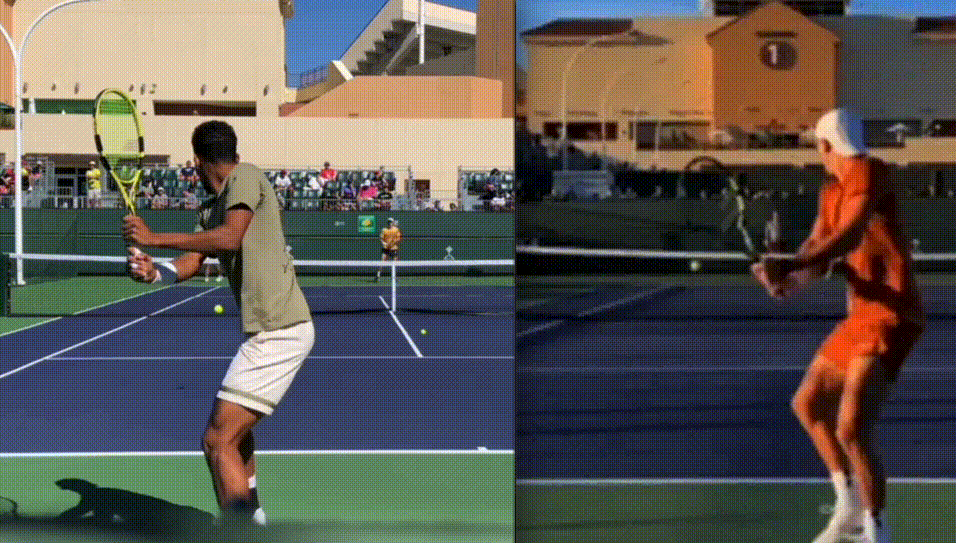
Like Rune, Sinner also has this manufactured flip, where the hands and racquet are thrown backwards as he steps forward into the ball:

You can see that an outside setup and swing/hand path can work when there is little drop, like with Norrie, Kyrgios, Alcaraz, Carreno Busta, Mannarino, de Minaur, etc. See below the similar setups between FAA and Pablo Carreno Busta, but the Spaniard has almost no drop, so he can easily drive the ball and time it well.
Of course, top pros know their weaknesses, but correcting them are exceedingly difficult, especially given the short off-season and constant pressure to perform in professional tennis. As I wrote in the Zverev vs Humbert Paris recap:
On first appearances improving weaknesses seems the low-hanging fruit, but the problem is that motor patterns and old habits make that fruit tree feel more like a Californian Redwood. There’s a lot of work that goes into moving arms, wrists, and racquets even a few inches, akin to steering a cruise ship with an oar. But if you can do it, the payoffs are large.
…Well it’s about time we get into the match I reckon.
First Set
Weaknesses aside, FAA has been on fire this year, winning titles in Adelaide and Montpellier, and reaching the semifinals in Doha before losing to eventual champion Rublev in a third set tiebreaker. He owns a tour leading 16 wins so far in 2025. His success has been built on the strengths of his game firing — the serve and forehand are both very good — as well as the movement looking sharp again after some injury issues in the past 18 months. Both men showcased their improvements in an early exchange:

Felix was the first to sniff a chance, earning two break point chances at 2-1 15-40, but Tsitsipas found an ace on the first one and never lost control with his forehand on the second.
Through the first five games the Canadian looked the sharper of the two. Tsitsipas’ backhand looked very Tsitsipas-ish in the old sense: missing, weak slices. We didn’t see something promising until he held for 3-3:
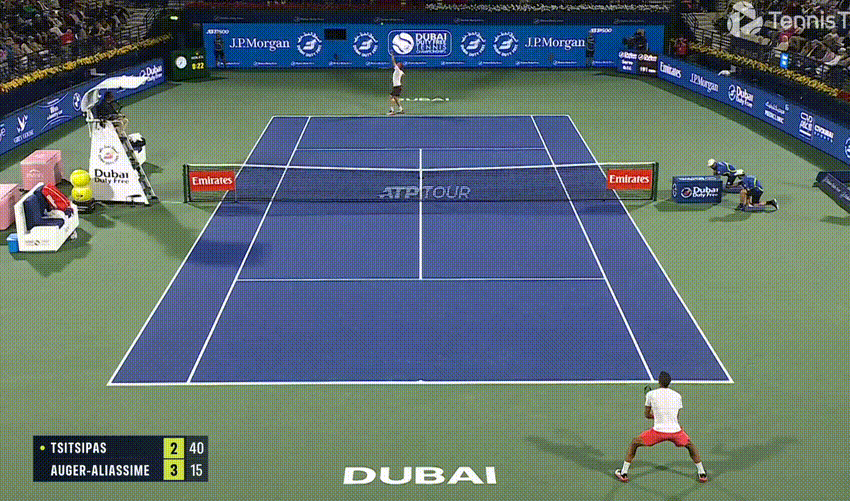
FAA was motoring through his 3-3 service game with typical serve-plus-one excellence:

But from 40-0 up it would be the last point FAA would win in this game, each point lost through a pattern of loose play from the Canadian (two missed forehands and a double fault) interspersed with Greek brilliance:
However, as soon as the Greek had earned a break he was in danger of giving it back, saving two more break points at 30-40 and Ad-out. Both times Tsitsipas found a first serve into the FAA backhand. The first went unreturned, prompting this piece of commentary:
“Contrast there on that return to the previous game to Tsitsipas, where a couple of times he knew the serve was coming to the backhand and he really middled the return. Chance missed there for Aliassime.”
The second was dealt with an impressive serve-plus-one forehand:
Returning at 5-3 is where Stef’s backhand really shone. He handled a first serve and kept his rally ball quality high on the next backhand to open his game account:
Then he got a look at a second serve and found perfect depth on the next backhand return:
Then he again found another perfect backhand return to setup his forehand, finishing with a delicate drop shot.

The greek would break at 15-40, making his forehand return off a first serve, as FAA made another forehand error to close out the set. The scoreline didn’t really reflect how close the set had been, especially in the opening games, but down the stretch the Greek just found better stuff on key points.
“It wasn’t free-flowing from Tsitsipas. He was just able to turn up the dial in important moments.”
— Tennis TV
Second Set
Tsitsipas found himself down a break point on two more occasions early in the second at 1-1. Again he found two first serves, and again the plus-one forehand was rock solid:
That’s six break points saved with six first serves. FAA did his job on these two, making respectable returns, but the Greek hit his forehand fearlessly.
The very next game the Tsitsipas backhand again came through strong, handling first serves from his aggressive return position:
Tsitsipas would earn two break point chances at 15-40. FAA found a first serve into Stef’s backhand, earned a weak reply, and approached into the backhand to force an error. At 30-40 he served to the forehand and they played an incredible point, probably the best point of the match, with Stef retrieving from the deep with sliding defensive lobs, and FAA on the attack, before FAA finally put away an overhead. FAA would go on to hold, but even from here it was made laborious by virtue of Tsitsipas again jagging back backhand returns and extending rallies in ways that haven’t been part of Stef’s DNA in recent times. It’s building pressure brick by bri — I mean, backhand by backhand, and that pays off at some point.
There was some miles on the body of FAA for sure, who was forced to a deciding set in all four of his matches enroute the final here, but his movement — especially to the defensive backhand — was pretty impressive and a good reminder as to the calibre of athlete he is.3 At 2-2 30-30 he kept asking seriously good questions of the Greek, who kept having all the answers when it mattered:
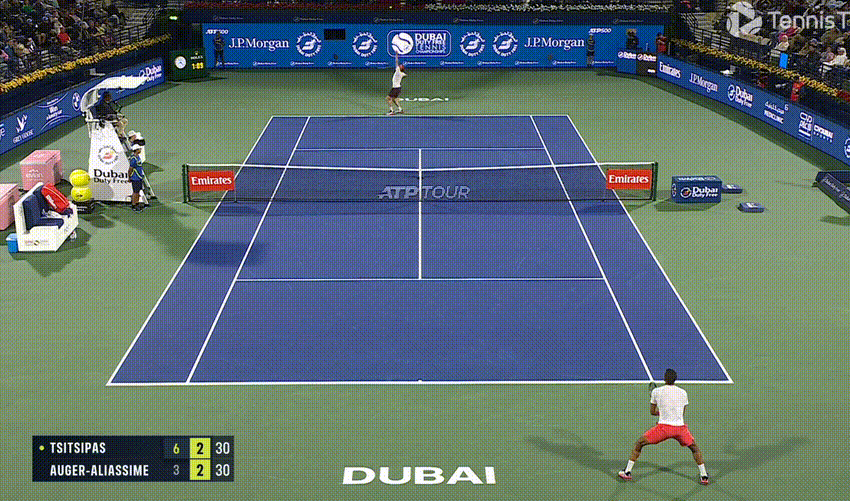
FAA held easy for 3-3 and Tsitsipas looked like he was heading for a similar easy hold at 40-15, but FAA started landing haymakers with the forehand. A mix of relaxed fatigue and confidence oozed from his strokes, and it was actually Tsitsipas who looked the one who was out of breath and struggling with the intensity and pace of play. I thought the overall baseline quality was pretty high from these two. You could tell how keenly aware each was to get on the front foot and dictate. There was no evidence of second guessing themselves on any shot, just instinct and athleticism. Tsitsipas held with a blistering stretch forehand:
The Greek owns one of the games best forehands, and I’ve always loved how well he can spread the court, finding sideline breaking forehands in both directions.
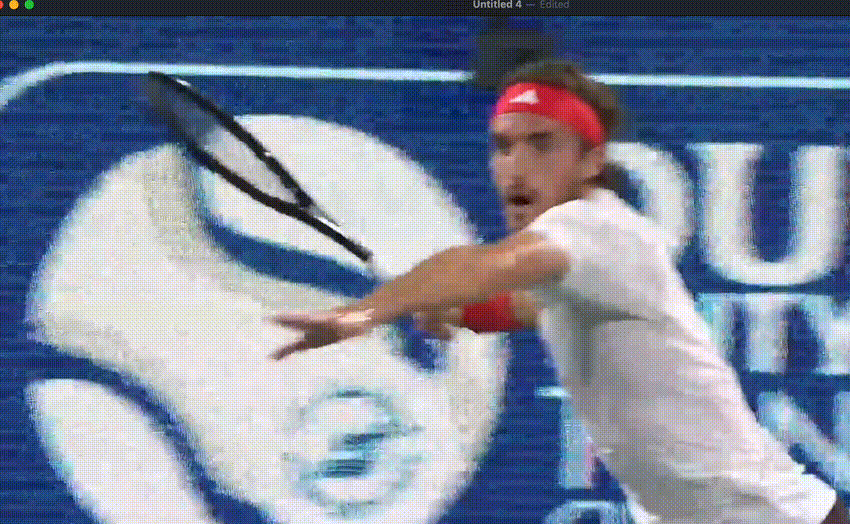
He also has one of the most unique flips in the game in my book.

At 4-3 another Tsitsipas laser return from the baseline, this time off a 215km/h heater
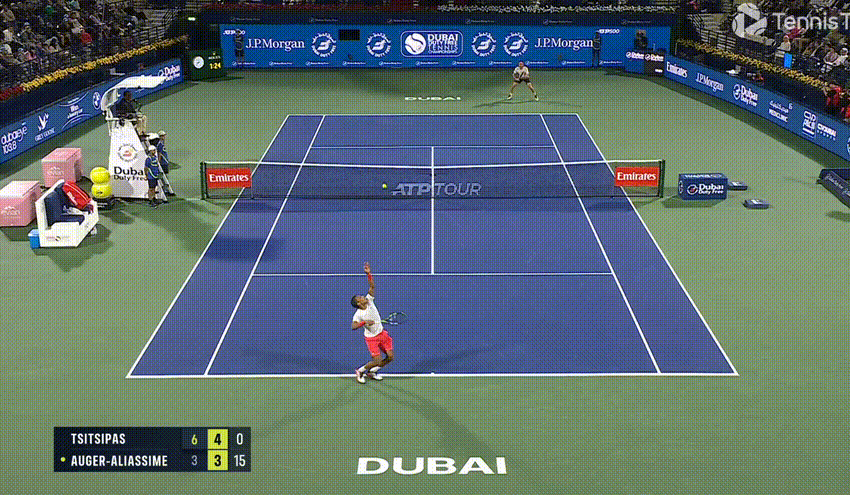
On break point FAA played the percentages, taking his second serve into the backhand and playing to the backhand. But yet again, the backhand held up:
Tsitsipas held to love to finally win a 500. Djokovic was quick to congratulate:
Final Thoughts
This was a match largely of opportunity. FAA created seven break points in four different games and converted none, courtesy of Tsitsipas playing elite on each one:
Ace
First serve to forehand, wins with a couple of forehands. Was always in control.
First serve to backhand. Unreturned.
First serve to backhand into plus-one forehand winner.
First serve to backhand into plus-one forehand winner.
First serve to forehand into plus-one forehand winner.
First serve into backhand. FAA’s best chance in an even and high quality rally.
Seven for seven on first serves, followed by controlled aggression with the forehand.
By contrast, Tsitsipas created six break point chances in four games and FAA went:
First serve, forehand error on plus-one. FIRST BREAK
First serve to backhand. Unreturned.
First serve to forehand, error on forehand rally ball. SECOND BREAK
First serve to backhand, plus-one forehand approach into Tsitsipas backhand forces an error from the Greek’s passing shot attempt.
First serve to forehand. They play a long rally, best of the match. FAA seals it with an overhead.
Second serve into backhand, forehand error on third groundstroke. THIRD BREAK
Three breaks courtesy of three forehand errors from FAA. The margins are thin. You could argue that FAA gifted the first break from 40-0, but the second and third breaks were earned by Stef. With their big serves, aggressive playstyles, on this type of court, it was always going to come down to a few points, and tonight FAA’s forehand was the shot that let him down in key moments.
Overall, while this post is largely about Tsitsipas and his backhand with a new stick, has the tactic to beat Tsitsipas changed in any meaningful way? No. You still need to rely on getting cheap points by serving to the backhand. It’s still the weakness in his game. But if the racquet change is the reason for the improved backhand, that weakness has been patched in a big way. You won’t get as many unreturned serves. You won’t get as many weak replies. More return slashes will arrive at your feet and put you under pressure. You will probably have to serve to the forehand more to create more of a surprise factor; something that wasn’t really needed in recent times.
I also think the Tsitsipas serve and forehand, the core of his game, looked better as well. He’s still a serve plus-one forehand kind of guy, and he didn’t appear to have any trouble controlling the more powerful frame with his stronger side. Everything looks better.
“I think it’s fair to say Mikey, that the racquet and string combination that he’s trialing this week might be here to stay.”
“I think so. It’s looking good isn’t it? I mean he’s noticeably getting more heat on the shots.
“Yeah I honestly don’t think it’s a coincidence. He was capable with his old racquet and string setup of coming here and having a good week, but, I’ve noticed the difference. The backhand return has been probably the best I’ve seen it in recent times. He’s hit his backhand really well in the rally. Even the serve and forehand seem to have that little bit extra. But also I think sometimes, mentally, just an equipment change can give you a freshness, a fresh start, a bit of a spring in your step on the practice court, you’re trying something new. It’s certainly worked for Tsitsipas this week.”
— Tennis TV Commentary
Tennis Insights found that it was the attacking forehand that led the way:
Stef’s usually pretty cringe on the socials, but this was solid:
Indian Wells is just around the corner. See you in the comments. HC
It’s impossible to know specs for sure as pros customise their frames with lead tape/silicone, custom layups and moulds provided by their sponsored company, but comparing a stock blade to a stock Babolat Aero 98 reveals a general trend towards more power and more forgiveness on off-centre strikes; something welcomed in the Tsitsipas backhand corner. In stock form the Babolat is stiffer (due to a wider beam, 23mm for the Babolat, and 21mm for the Wilson) and has a more open string pattern compared to the stock Wilson (emphasis added):
“The most common string patterns are 16/19 and 18/20. There are variations in between, but in general, fewer strings give more spin and power, while more strings or denser string patterns provide more directional and depth control. The string pattern also affects the launch angle of the ball leaving the racket. More open string patterns have higher launch angles, meaning that the ball flies higher above the net. This, of course, holds true if everything else is equal in terms of strings and racket set up. For example, you can make an open string pattern play more like a dense one with thicker strings and vice versa. Denser string patterns also result in a stiffer string bed and less string movement, while more open patterns enable strings to move more and feel softer. String movement is one of the main factors that affect how much spin can a racket impart on the ball.”
As I wrote back in 2023:
In motor learning literature, learning skills—especially complex skills that are multi-segmented and numerous in their degrees of freedom, like tennis strokes—are often hard to perfect because it is not always clear where in the skill the movement was off, and how one should correct it. There is no consensus out there on the one best way to hit a particular shot, and often the subtle differences in a swing are a delicate balance of tradeoffs, but by looking for similarities in the best shots, we can identify the features that continually show up. Features that consistently appear in the best strokes can then be said to represent the “global” maxima of technique, whereas features that continually appear to be sub-optimal may only represent a "local" maxima. No matter how talented one is, wielding the local maximum will always have ceiling effects.
For more on motor learning and local vs global maximums see:
Lohse, K., Miller, M., Bacelar, M., & Krigolson, O. (2019). Errors, rewards, and reinforcement in motor skill learning. In Skill Acquisition in Sport (pp. 39-60). Routledge.
You can find it on Google Scholar here. It’s actually a great article. Another take away from it was the idea of prediction errors, that we don’t learn from our mistakes, we learn when our outcomes deviate from our expectations. So even doing something very well, and the result being surprisingly good, is a learning outcome.




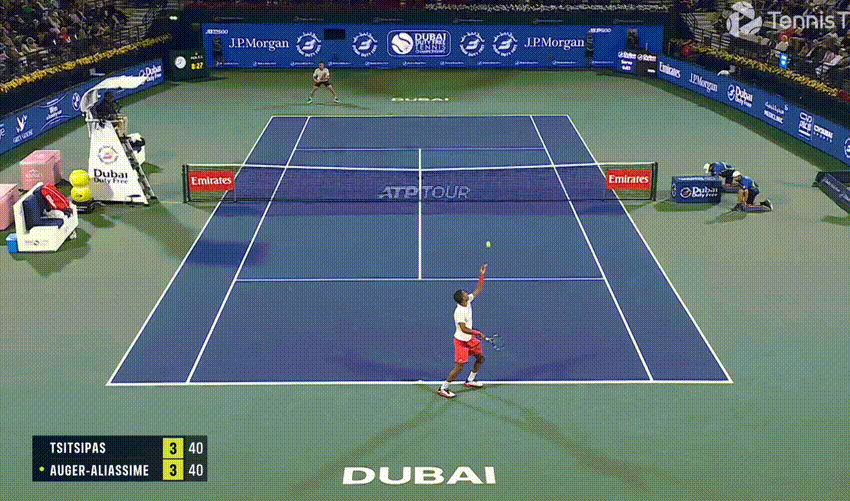
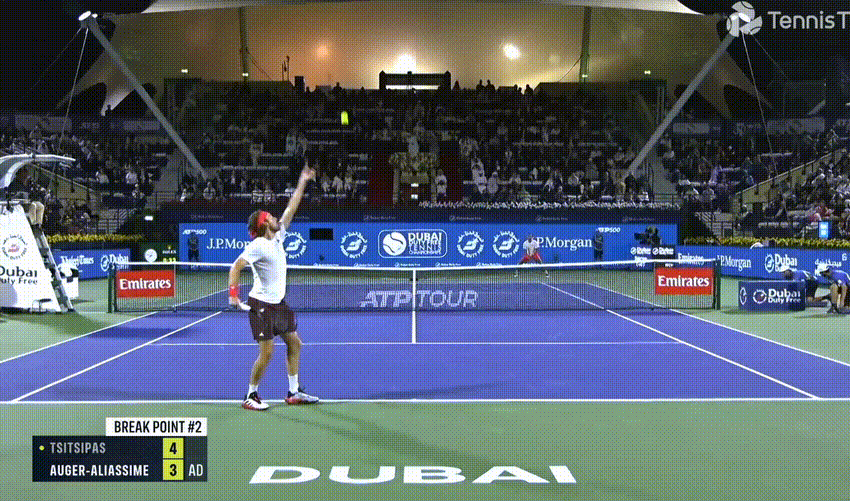
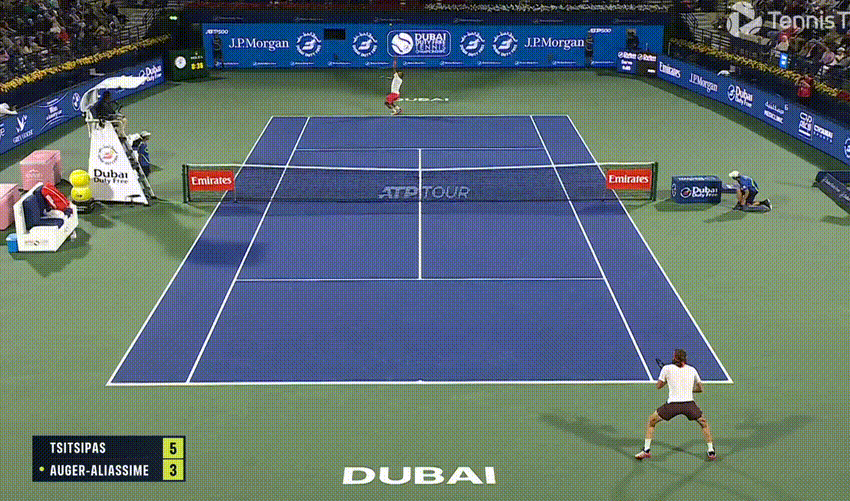
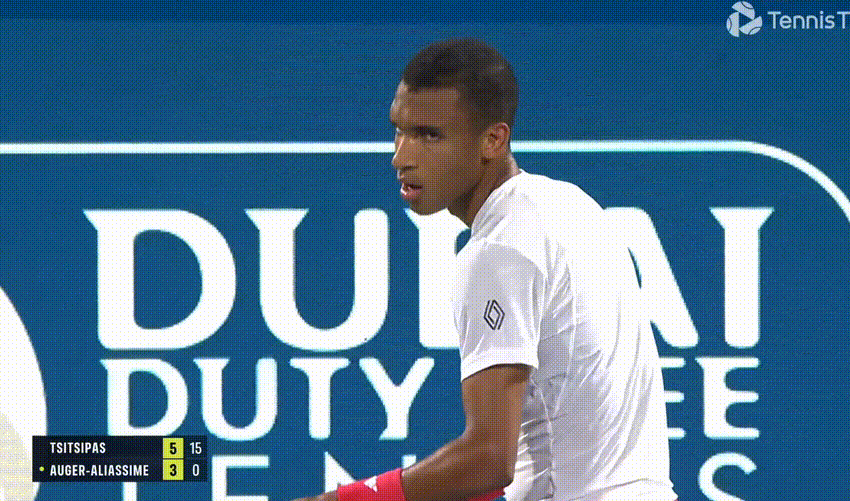










Dying to read death of a forehand’s latest installment. FAA backhand seems to lack a bit of coil in that he doesn’t wrap around at all. Almost like it is too modern. Great stuff on Stef!
Hi Hugh,
Great write-up, as always. A question regarding the inclusion of Alcaraz in the "outside hands but works thanks to little drop" category. Back in Hambourg 2023 which is the first analysis I remember where you gave criticism to Carlos's BH, you pointed out the outside-hands setup as well as the lack of a great racket drop, but in this one you saw that as sort of a weakness while not comparing him straight to the Norrie/Kyrgios flat BHs of this world.
Then, over the months/years, I actually saw you praising Carlos's racket drop and use of gravity (especially in comparison with Rublev's) thanks to his bent elbow/higher position. The loss of this elbow extension early in the setup while not having a big in to out flip is what prompted you to predict a Alcaraz BH regression in 2025 which so far to me looks to be holding up (small sample). Because, and that's my question, I don't know if we can group Alcaraz's newer BH with the likes of ADM/Norrie/Mannarino yet. As you said, it's not as aenemic/flat, I feel like he is still trying to get some racket drop, but it's not as efficient as it previously was.
That's why we could talk about a regression rather than a simple technical change that leads to trade-offs.
The one thing I still love about Alcaraz's BH is something you talked about last week again in comparison to Rublev's, is the locked-wrist follow-through, which aids in control as well as redirection/absorption from deep in the court